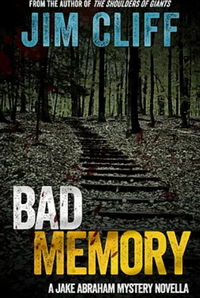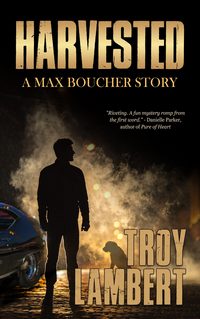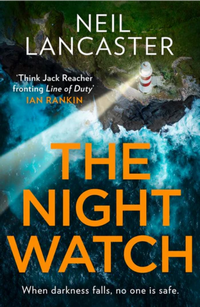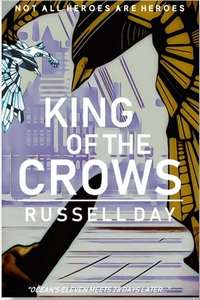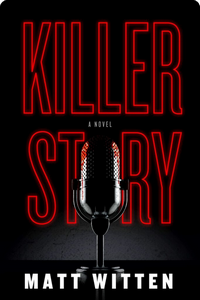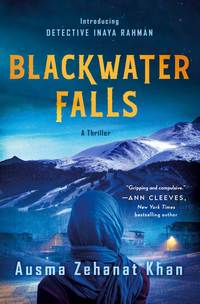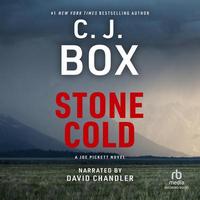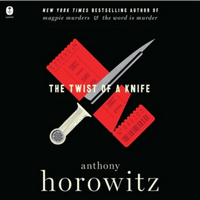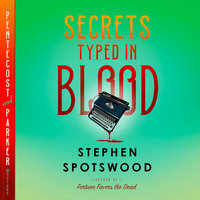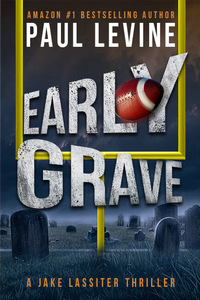by Ausma Zehanat Khan
DETAILS:
Series: Blackwater Falls, #1
Publisher: Minotaur Books
Publication Date: November 7, 2022
Format: Hardcover
Length: 371 pg.
Read Date: January 10-12, 2023


She’d thought to herself many times that the town was too shiny, too perfect, a vision of Americana, with fern-green pastures unfurling north of the reservoir, and pickup trucks and ranches that spoke of a vanished dream: the hardworking people of the heartland.
But there were hate crimes and harassment in this heartland, communities who lived at the mercy of their employers, and vigilantes and cops who were there to make them obey. In Chicago, the exercise of power was naked and direct; she knew that all too well. Blackwater’s old-fashioned gentility masked its insistence on the status quo, an insight that made her uneasy.
What’s Blackwater Falls About?
Well, I could put this in a very bare-bones way—a pair of detectives take over a murder investigation in a small town outside of Denver. There’ve been a number of complaints about the Sherriff, so Denver PD has sent them. One high school girl has been killed, and there are rumors of two others that are missing. The detectives deal with local roadblocks, an antagonistic Sherriff’s department, and some internal troubles as they search for answers.
This is not a new idea to Police Procedurals—at all. And for good reason—that’s the makings of a good story. But…let’s put some meat on those bones and see what Khan does that makes this novel stand out.
Detective Imaya Rahman has recently moved from Chicago to Denver, following some professional failure and personal trauma (it’s initially unclear what both were). She’s part of the Community Response Unit—which is assigned to any case calling for police accountability, particularly in cases involving overpoliced communities/areas. The unit was formed following the protests of 2020, and Rahman was involved in police oversight back in Chicago, it was a natural fit. The murder victim—a Syrian refugee—was a member of the same mosque that Rahman and her family attends (her father’s a criminal defense attorney, and her younger sisters attend a local college, I’m not sure what her mother does other than worry about getting her daughters married), and was discovered in that mosque. Her body was posed and displayed in a way that seemed to invoke both Christ’s crucifixion and the Virgin Mary. Between the victim, the building, and the imagery—this screams hate crime. And the tensions between the Sherriff’s Department and the (largely immigrant) Muslim community in the area are at a boiling point.
Enter CRU and Det. Rahaman, in particular. Her partner was a former trauma therapist who moved into criminal psychology, bringing valuable insights and profiling abilities. Before joining the CRU, Det. Catalina Hernandez had worked for years on the border helping immigrants with legal and medical aid. With her eye for detail, her ability to relate to the immigrant population of Blackwater Falls, and her people skills; and Rahman’s investigative instincts and shared background with the victim’s families—they’re the ideal team for this case.
There’s no dearth of suspects—there’s an evangelical megachurch in town where the preaching is as frequently anti-Muslim and anti-immigrant as it is pro-Christ. There’s the Disciples, a Christian motorcycle club—they appear to be the enforcers of the outlook of said megachurch (and make an aggressive appearance at the victim’s home the day of her body’s discovery). There’s the private (and very white) school the victim attended, where she’d been harassed and assaulted for her race, her apparel, and her success. Part of that success was getting a coveted internship at a local tech firm that she’d recently been fired from. Lastly, her father had been part of a movement to organize a union at the plant he worked at—and management’s response was both aggressive and seemingly targeted at the families of the organizers.
It seemed like a large suspect pool when I was reading it, but having typed it all out just now, it seems even more daunting.
As I said earlier, the Sherriff’s department is hostile—naturally because no one likes being pushed off a case, and possibly because there’s a good reason for them to be removed. At the same time, they seem awfully well-informed about what’s happening in the investigation (as do some of the potential suspects)—does the CRU have a leak?
The Subplots/Worldbuilding
Yeah, even with all of that going on, Khan is able to work in a handful of subplots—some of which serve the story, some establish the characters, and some help build the foundation of a series. It doesn’t feel over-stuffed and nothing is given short shrift. I’m not going to go into them all at this point because I don’t want this post to get too long, so I’ll be vague here.
This is a fantastic world here (well, okay, it’s a horrible world because it’s pretty realistic—but it’s a fantastic world for the purposes of an ongoing series. I’m pretty sure that the entities that proved to have nothing to do with the murder will be seen again in relation to a future crime.
The tensions and problems within the CRU will give all the characters opportunities for growth and development as that Unit becomes better (or devolves into uselessness).
Over the course of the case, Rahman and Hernandez form an alliance (and possible budding friendship) with a local attorney and minority rights activist—the potential for mutual aid and clashes within this group of women alone is enough to fuel readers’ imaginations for a few books.
Also, you have to account for Rahman’s backstory, family, and potential romantic entanglements that we’ve only scratched the surface of in this book, it’s going to take a few more to really explore all of this. And I’m sure the other members of the team could have similar arcs as well.
Culture Clashes
Blackwater Falls is a pretty diverse community at the present (but not historically)—you’ve got the families that have made this community over the generations—largely white, Protestant (of various types), and moderately-to-very affluent. There’s a new Muslim community appearing—Rahman’s family, Syrian refugees, and significant numbers of Somalis—largely brought into do blue-collar work. Denver’s CRU itself is pretty diverse.
The key to both success when it comes to this case and for the health of the community is understanding each other to some extent. Khan makes this point subtly throughout, but you can’t walk away from the book without it making an impression. The detectives struggle to overcome their lack of understanding of parts of the communities, cultures, and religions in the town, as do the citizens/residents, the suspects, and (I think I can say without spoiling anything) even the killer is tripped up by not really understanding things. The lack of mutual respect and awareness will destroy this unit and community until bridges are built—and used.
For the way she handles this theme alone, Khan deserves a kudos or two.
So, what did I think about Blackwater Falls?
I think I’ve tipped my hand already here. I was very impressed by this book—I’ve seen a lot of people talk about how a good police procedural can be written post-George Floyd. Here’s the answer. Khan tackles the struggles of a police department trying to do the job they’ve always done while making slow changes and resisting others—the CRU’s lieutenant (who I’ve ignored solely for reasons of space up until now) is the poster child for this. There are outside voices wanting these changes to happen more rapidly and others decrying the entire idea—and these detectives are stuck in the middle while trying to stop a murderer.
Is this a template for others? No. But it’s a shining example that the subgenre can survive and thrive. Possibly even drawing new readers in, too.
The character work—both major and minor—is fantastic, there’s not one of them that couldn’t walk off the page as a living, breathing person. The pacing is tight. The tension is organic and ratchets up throughout just the way it should. The mystery(ies) are well-plotted and executed. Khan left a giant red herring for readers to be distracted by, wondering why the detectives weren’t following one line of investigation—and my notes are full of my grumbling about it, smug in knowing that I’d figured out a significant part of the case (and maybe the killer’s identity) hundreds of pages ahead of them. And as I called it a red herring, I clearly couldn’t have been more wrong, but I didn’t give up on it until I had to.
Right now, I have this sense that there are a point or two that I intended to make that I’ve completely forgotten about—and I feel bad about that, because this is one of those books that you can really sink your teeth into. At the same time, I have a sense that I’m nearing the “said too-much” line, so I’ll leave this here and not try to think of those neglected points.
This is a great procedural in the way it embraces the defining traits and pushes them in new ways, it’s a great character study, a good commentary on several issues facing the country—and it’s a pretty solid mystery, too (can’t forget that). I’m more than eager to see where this series goes next. Get your hands on this one, friends.

This post contains an affiliate link. If you purchase from it, I will get a small commission at no additional cost to you. As always, the opinions expressed are my own.

 A Man Named Doll
A Man Named Doll

![]()



